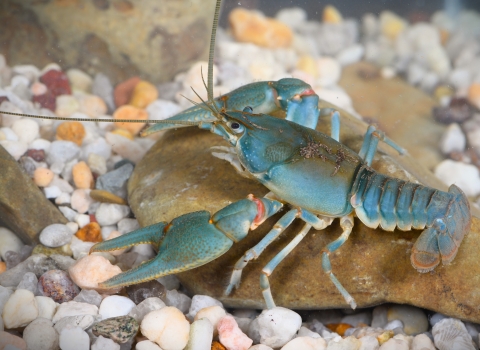About a month ago, biologists with the U.S. Fish and Wildlife Service (Service) released two groups of Puerto Rican parrots into a national forest in Puerto Rico – the first birds to fly free in the forest since two hurricanes devastated the region more than two years ago.
Marisel Lopez-Flores, left, Project Leader for the Puerto Rican Recovery Program, and Iris Rodriguez, a Biological Science Technician with the program, tend to parrots at the El Yunque National Forest aviary in Puerto Rico. In late January and early February the U.S. Fish and Wildlife Service released 30 parrots into the wild. At the end of February, all were alive.
As the birds flew away, biologists crossed their fingers and wished for the best.
Those wishes, so far, have come true: Of the 30 parrots released at El Yunque National Forest in late January and early February, all have survived their first month in the wild. That’s about twice the survival rate that biologists anticipated.
The findings have scientists chirping with excitement.
“The birds’ survival rate is fantastic news,” said Leopoldo “Leo” Miranda, Regional Director of the Service’s South Atlantic-Gulf Region, which includes Puerto Rico. “The Puerto Rican parrot is like Puerto Ricans themselves. Both are resilient and can take the worst nature throws their way. This bird, like the people of Puerto Rico, will not only survive but thrive.”
People working directly with the endangered parrot cheered the news, too.
“It’s great to see Puerto Rican parrots flying in El Yunque again,” said Tom White, a biologist who works with the birds in the Service’s mountainside aviary at the 29,000-acre national forest. The aviary received more than $5.61 million in supplemental funding following Hurricanes Irma and Maria in 2017.
Irma came first, battering the island in early September 2017. Maria followed less than a month later. It practically denuded the rainforest where the aviary is located.
White and his wife, Arelis Johnson, remained in the aviary during Maria to protect more than 240 captive parrots. Those birds survived, but those in the wild did not. Service and USDA Forest Service staff began planning to reestablish a wild population in the forest.
On Jan. 30, they released 15 birds. A week later, 15 more parrots took flight from the aviary. Surveys conducted in late February showed all were alive.
The Service did not accomplish this success alone, Miranda added.
“I also have to thank the USDA Forest Service, whose rainforest provides such a great habitat for the parrot, the National Fish and Wildlife Foundation, and the Commonwealth of Puerto Rico for their strong commitment to recover this species.”



